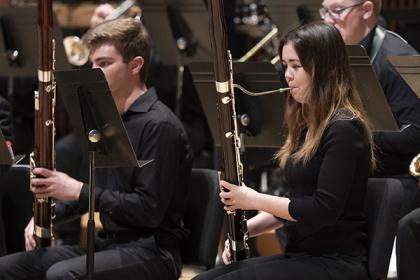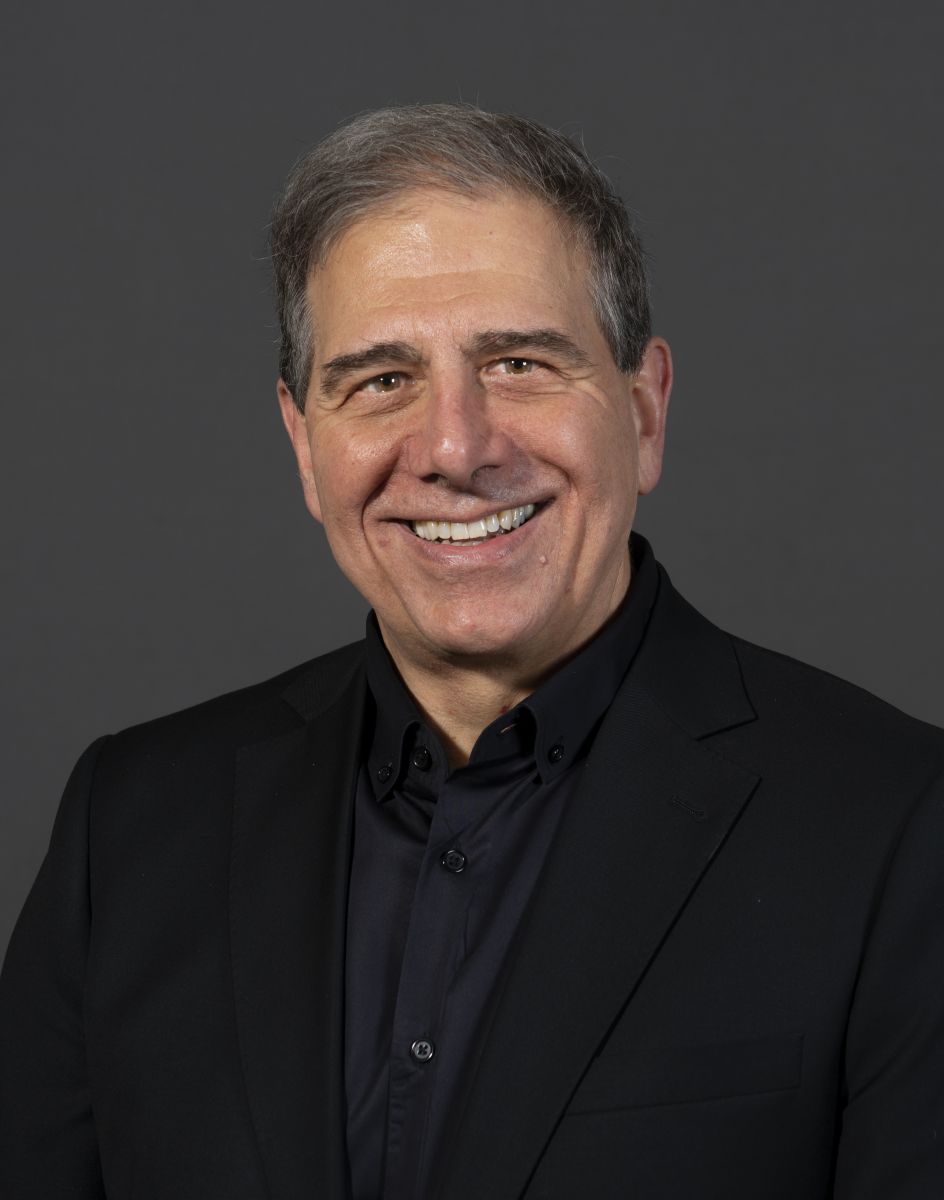Impressions of…: UMD Wind Orchestra - IN PERSON
Impressions of… - IN PERSON

Michael Votta, Jr., conductor
Alexander Scott, graduate conductor
Event Attributes
Presented By
For more information regarding accessible accommodations, please click here.
This evening of contemplative works will explore the variety of ways that outward impressions can influence inward feelings. First, experience the English seaside in Ruth Gipps’ Seascapes. Then, absorb Arnold Schoenberg's masterful Chamber Symphony Op. 9—the first work to distill a symphony into one movement. Don’t miss the performance of Kung Fu by award-winning Chinese composer Shuying Li. Commissioned by the UMD Wind Orchestra, Li captures the spirit of kung fu in three movements. Finally, Jules Strens' Danse Funambulesque (Tightrope Dance) is literally a "high-wire" act, depicting his impressions of seeing aerialists in action—leaping, flying and twirling in death-defying stunts.
Program:
Ruth Gipps: Seascapes
Arnold Schoenberg: Kammersymphonie (Chamber Symphony) No. 1, Op. 9
Shuying Li: Kung Fu
Jules Strens: Danse Funambulesque (Tightrope Dance)
About the UMD Wind Orchestra (UMWO):
Led by Michael Votta, Jr., UMWO is a leading voice among collegiate ensembles in premiering new works for winds. This season’s engaging performances will feature faculty soloists and world premieres of new works and masterworks of the 20th and 21st centuries.
Health + Safety
There may be COVID safety policies such as mask requirements in place when you attend this event. Please see our health & safety page for the most up to date information about attendance!
fghgf
MENU: PROGRAM • PROGRAM NOTES • ABOUT THE ARTISTS
PROGRAM
Seascapes.....................................................................................................................Ruth Gipps
(1921-1999)
Alexander Scott, Conductor
Kammersymphonie No. 1, Op. 9.....................................................................Arnold Schoenberg
(1874-1951)
INTERMISSION
Kung Fu.........................................................................................................................Shuying Li
(b. 1989)
Danse Funambulesque................................................................................................Jules Strens
(1893-1971)
PROGRAM NOTES
Seascapes
Ruth Gipps
Born: February 20, 1921, Bexhill-on-Sea, United Kingdom
Died: February 23, 1999, Eastbourne, United Kingdom
Composed: 1958
The score calls for 2 flutes, oboe, English horn, 2 clarinets, 2 bassoons, 2 horns and string bass.
Duration: 8 minutes
In a time where orchestras, wind bands and military bands were male-dominated, British composer Ruth Gipps was a pioneer in the world of music composition and performance. She founded and conducted the Portia Wind Ensemble, a group made up entirely of women. This group was an important part of music in Britain, and they premiered works by Gordon Jacob, Peter Maxwell Davies, Harrison Birtwistle, Alan Hoddinott, Wilfred Josephs and John McCabe. Seascapes, composed by Gipps in 1958, was written for and premiered by the Portia Wind Ensemble.
Seascapes is a programmatic work, thought to be inspired during a trip to the coastal town of Broadstairs in Kent, where Gipps was giving lectures. About her stay, Gipps said: “I spent the night in a hotel right on the beach. I could hear the sea. I always loved the sound of the sea and particularly storms.”
This piece is written for double wind quintet, with an English horn used in place of a second oboe. The edition by Rodney Winter used for this concert uses an optional string bass which brings further depth and color to the composition.
— Program Note by Christine Higley
Kammersymphonie No. 1, Op. 9
Arnold Schoenberg
Born: September 13, 1874, Vienna, Austria
Died: July 13, 1951, Los Angeles, California
Composed: 1906
The score calls for flute, oboe, English horn, 2 clarinets, bass clarinet, bassoon, contrabassoon, 2 horns, 2 violins, viola, cello and string bass.
Duration: 20 minutes
When Schoenberg completed the Kammersymphonie (Chamber Symphony) No. 1 in 1906, he told his friends: “Now I have established my style. Now I know how I have to compose.” He quickly realized this was not true: as he put it, he was “not destined” to continue in this post-Romantic manner. Looking back, he saw that the Chamber Symphony was only a way station—but an important one—on the road toward his goal, which was to master what he described as “a style of concision and brevity in which every technical or structural necessity was carried out without unnecessary extension, in which every single unit is supposed to be functional.” Within a few years, Schoenberg was composing an astoundingly dense, non-repetitive, richly detailed new music: the Stefan George song cycle Das Buch der hängende Gärten (The Book of the Hanging Gardens); Three Pieces for Piano, Op. 11; Five Pieces for Orchestra, Op. 16; and the one-character opera Erwartung (Expectation), all completed in 1909, had gone far away from the luxuriant Romanticism of the earlier Verklärte Nacht and Gurrelieder. Something that did not change was Schoenberg’s artistic personality and his temperament. From Verklärte Nacht to the last scores, passion is a constant, and the most immediate and ultimately overwhelming impression the Chamber Symphony No. 1 makes is that of urgent, ardent, even wild utterance.
The Chamber Symphony is in one movement; it is also in five movements. Schoenberg uses a formal device that had served him well in Pelleas und Melisande and the String Quartet No. 1: he combines the traditional four-movement plan—sonata allegro, scherzo, slow movement, finale—with that of a single sonata movement. Sections I, III and V are characterized sharply enough to encourage you to hear five distinct movements; at the same time, their mutual connectedness is so clear that the symphony’s master plan as a single sonata movement with extended interludes on either side of the development is also readily audible.
The Chamber Symphony opens with a great pile-up of notes that coalesce into a luscious five-note chord, which resolves ever so suavely into a chord of F major. As soon as the very fast main tempo begins, Schoenberg has the horn rush impetuously up the steep slope of fourths from D below middle C to the F at the top of the treble staff. After the horn call, the cello plays an energetic, upward-rushing theme easily recognized by its persistent triplets as well as by its Debussyan whole-tone steps. This moves forward to an intense climax, which is followed by a new melody for violin and horn in a broad, singing style. The first movement presents a series of fervent, spirited and variegated themes in rapid succession. The return of the energetic cello theme becomes a transition to the scherzo. The scherzo itself is even faster than the first movement; the ghostly Trio takes about twenty seconds. In the symphony’s main development section, the themes of the first movement are reconsidered, recombined and recostumed with captivating energy. Rising fourths introduce the slow movement, but now they take on the form of incorporeal double-bass harmonics, delicate six-note woodwind chords, weightless clarinet arpeggios, a dreamy melody for the first violin, all pianissimo. The music that ensues is a feast of lyric inspiration. The finale recapitulates and sometimes further transforms earlier themes with great freedom in their order of appearance. The rising fourths and the excited theme from the beginning of the first movement return in the coda. The close, with exultant horns and emphatic assertions of E major against the chromatic current, is joyously exuberant.
— Program Note by Michael Steinberg
Kung Fu
Shuying Li
Born: 1989, China
Composed: 2019
The score calls for piccolo, 2 flutes, 2 oboes, English horn, E-Flat clarinet, 3 clarinets, bass clarinet, 2 bassoons, contrabassoon, soprano saxophone, alto saxophone, tenor saxophone, baritone saxophone, 2 bassoons, 4 horns, 3 trumpets, 2 trombones, bass trombone, euphonium, tuba, timpani, wood blocks, xylophone, bass drum, ratchet, glockenspiel, tam-tam, congas, whip, chimes, claves, lion’s roar, flexatone, drum set, wind chimes, crash cymbals, suspended cymbal, bongos, vibraphone, triangle, harp, double bass and piano.
Duration: about 17 minutes
The composer writes:
Whenever people talk about Kung Fu, they will think of China. However, as a composer who was born and grew up in China, my understanding of the term Kung Fu was rather ambiguous and confusing. True, Kung Fu has a strong link with Martial Art, which has attracted hundreds and thousands of admirers and followers worldwide. However, on the other hand, Kung Fu has become an umbrella term that extended its tentacles in all aspects of Chinese people’s daily life, such as popular culture, exercise regimen, interpersonal relationship, aesthetic, philosophy and so on.
It was not until I encountered a documentary on Bruce Lee’s journey with Kung Fu and Hollywood did I start to comprehend the core of the spirit that Kung Fu has in guiding one’s endeavor and life pursuits. So, I decided to compose a work with my own reflection of Kung Fu and its spirit.
In three movements, Kung Fu explores the different styles and levels of meanings of what Kung Fu represents to people, in a rather universal way. A more general summary of the Wushu spirit in the first movement, a contrasting second movement focusing on the soft yet powerful Tai Chi, both lead to the final movement of “Jiang Hu.” As Bruce Rusk, a professor of the Department of Asian Studies in the University of British Columbia interpreted, “Jianhu...refers to a social space in which people are away from familial and local ties for extended periods that are governed by informal rules (officials away from home are not in jianghu). But I don’t have a good catchall translation. In this case, it could be “the scene,” as Kaiser Kuo suggests, or even “everyone” (implicitly, everyone involved in martial arts).” Jianghu, in this case, is also a representation of my ultimate understanding of Kung Fu, it represents a universal rule, belief and a practice that are rooted in all of us, and it catalyzes to connect people in different backgrounds for a more harmonized society.
Kung Fu was commissioned by a consortium of 20 college bands organized by conductor Glen Adsit and the Hartt Wind Ensemble.
— Program Note by Shuying Li
Danse Funambulesque
Jules Strens
Born: December 5, 1893, Brussels, Belgium
Died: March 19, 1971, Brussels, Belgium
Composed: 1925
This performance will use piccolo, 2 flutes, 2 oboes, English horn, 2 bassoons, contrabassoon, E-Flat clarinet, 3 B-Flat clarinets, bass clarinet, alto saxophone, tenor saxophone, baritone saxophone, 2 cornets, 3 trumpets, 4 F horns, 2 E-Flat horns, baritone (played on tenor sax), 3 trombones, bass trombone, euphonium, tuba, timpani, 2 snare drums, bass drum, suspended cymbal, crash cymbals and whip.
Duration: About 11 minutes
Jules Strens studied violin at the Royal Conservatory of Brussels. While there, he also received advice from Paul Gilson in orchestration. In 1926, he became a member of the Synthétistes, a group of young progressive composers of the twenties who were all pupils of Paul Gilson. During this period, he experimented with electro-acoustic music and began his musical career as violinist and composer. Starting in 1922, he was first violinist at the Théâtre Royal de la Monnaie. From 1931 to 1934, he was conductor of the Association Symphonique de Bruxelles. At the end of his life, he was more active as an organist.
As a composer, Strens was self-taught and prolific. Strens’ more mature works use techniques such as polyrhythm and ostinato (a musical motif or phrase that remains unchanged and stubbornly repeats). Examples of compositions where he employs these techniques include Danse Funambulesque as well as Danse Tragique and Rhapsodie Polyrythmique.
Danse Funambulesque was originally composed for chamber orchestra in 1925. Strens re-scored it for band in 1929 and added a dedication to Arthur Prevost, then director of The Band of the Belgian Guides. Prevost was a leading figure in the musical life of Brussels, leading the first Belgian performances of Stravinsky's Symphonies of Wind Instruments, Octet and Piano Concerto, among other notable works.
Danse Funambulesque is inspired by the death-defying feats of a tightrope walker at the circus. The piece begins with a quiet meditation, perhaps conveying the tightrope walker's moments before stepping out on the wire itself. This reverie gives way to a series of increasingly frenetic episodes that convey the ever-increasing tension of the high-wire act.
— Program Note by Christine Higley
ABOUT THE ARTISTS
ARTIST BIOGRAPHIES

MICHAEL VOTTA, JR.
Votta has been hailed by critics as “a conductor with the drive and ability to fully relay artistic thoughts” and praised for his “interpretations of definition, precision and most importantly, unmitigated joy.” Ensembles under his direction have received critical acclaim in the United States, Europe and Asia for their “exceptional spirit, verve and precision,” their “sterling examples of innovative programming” and “the kind of artistry that is often thought to be the exclusive purview of top symphonic ensembles.”
He currently serves as director of bands at the University of Maryland School of Music where he holds the rank of professor. Under his leadership, the UMD Wind Orchestra (UMWO) has been invited to perform at the international conference of the World Association of Symphonic Bands and Ensembles as well as multiple national and divisional conferences of the College Band Directors National Association. UMWO has also performed with major ensembles such as the Baltimore Symphony Orchestra, the Orpheus Chamber Orchestra, Eighth Blackbird and the Imani Winds. UMWO has commissioned and premiered works by Stephen Jaffe, Andre Previn, Steven Mackey, Alvin Singleton, James Syler and numerous others.
Votta has taught conducting seminars in the US, Israel and Canada, and has guest conducted and lectured throughout the world with organizations including the Beijing Wind Orchestra, the Prague Conservatory, the Eastman School of Music, the Cincinnati College-Conservatory of Music, the National Arts Camp at Interlochen, the Midwest Clinic and the Conductors Guild.
His performances have been heard in broadcasts throughout the US, on Austrian National Radio (ÖRF) and Southwest German Television, and have been released internationally on the Primavera label. Numerous major composers including George Crumb, Christopher Rouse, Louis Andriessen, Karel Husa, Olly Wilson, Barbara Kolb and Warren Benson have praised his performances of their works.
His arrangements and editions for winds have been performed and recorded by university and professional wind ensembles in the US, Europe and Japan. He is also the author and editor of books and articles on wind literature and conducting.
He is currently vice-president of the College Band Directors National Association. He has served as president of the Big Ten Band Directors Association and editor of the CBDNA Journal, and has been a member of the boards of the International Society for the Investigation of Wind Music (IGEB) and the Conductors Guild.
Before his appointment at Maryland, Votta held conducting positions at the University of North Carolina-Chapel Hill, Duke University, Ithaca College, the University of South Florida, Miami University (Ohio) and Hope College.
As a clarinetist, Votta has performed as a soloist throughout the US and Europe. His solo and chamber music recordings are available on the Partridge and Albany labels.
ALEXANDER SCOTT
Scott is pursuing a Master of Music in wind conducting at the University of Maryland, where he currently serves as an instrumental conducting graduate assistant. He is a conducting student of Professor Michael Votta, Jr., with additional mentoring from UMD faculty Andrea Brown and Craig Potter. In addition, he serves as assistant conductor for the Bel Air Community Band.
Before coming to UMD, Scott taught for nine years at the elementary, middle and high school levels in Maryland public schools. For seven years, he was the Music Department chair and director of instrumental music at Meade Senior High School in Fort Meade, Maryland, where he was responsible for conducting the concert band, string orchestra, philharmonic orchestra, marching band, jazz band, steelband and pit orchestra, as well as instructing International Baccalaureate (IB) Music, Advanced Placement (AP) Music Theory and guitar courses. Additionally, he served as the school’s advisor for the Tri-M Music Honors Society.
While teaching at Meade Senior High School, Scott’s bands and orchestras consistently earned excellent and superior ratings at county and state adjudication festivals, and his marching band earned second place at the 2018 USBands Mid-Atlantic Regional Championships. His concert band was a member of a commission consortium for Anthony O’Toole’s Latin Dance Movements. Scott was a semifinalist for Music and Arts’ national Music Educator of the Year award (2016) and the Maryland winner for School Band and Orchestra Magazine’s 50 Directors Who Make a Difference award (2018). His departmental leadership was twice recognized by the NAMM foundation with a Best Communities in Music Education designation (2018, 2019).
Scott earned his Master of Music in music education from the University of Michigan, Ann Arbor and his Bachelor of Arts in music education from the University of Maryland, Baltimore County (UMBC). While at UMBC, Scott served as the inaugural undergraduate conducting fellow with the Wind Ensemble. Scott is a member of the National Association for Music Education, the Maryland Music Educators Association and the Flute Society of Washington.
As a woodwind specialist, Scott enjoys performing flute, clarinet and saxophone in various community and amateur ensembles in the DMV area. He also plays the double seconds steel pan in the Baltimore-based steelband sextet, Charm City Steel.
UNIVERSITY OF MARYLAND WIND ORCHESTRA
Music Director
Michael Votta, Jr.
Flute
Natalie Bartholet
Ruyuan Li
Matt Ober
Hadas Sandalon
Erica Spear
Piccolo
Matt Ober
Erica Spear
Oboe
Katelyn Estep
Joshua Faison
Michael Helgerman
English Horn
Katelyn Estep
Michael Helgerman
Bassoon
Joseph Florance
Patrick Heinicke
Jimmy Ren
Alex Wiedman
Contrabassoon
Jimmy Ren
Alex Wiedman
Clarinet
Kyle Glasgow
Chase Hogan
Ashley Hsu
Brooke Krauss
Katie Urrutia
Lauren Walbert
Andrew Zhang
E-Flat Clarinet
Kyle Glasgow
Ashley Hsu
Bass Clarinet
Chase Hogan
Brooke Krauss
Andrew Zhang
Soprano Sax
Joshua Mlodzianowski
Alto Sax
Joshua Mlodzianowski
Emily Wolf
Tenor Sax
Lauratu Bah
Willie Hadnot
Baritone Sax
Abigail Jones
Horn
Garrett Cooksey
Emerson Miller
Zach Miller
Kat Robinson
Isaac Vallecillo
E-Flat Horn
Kat Robinson
Kaitlyn Winters
Trumpet
Antony Eleftheriou
Alfred Muña
Jacob Rose
Brennan Rudy
Reece Updike
Trombone
Eusung Choe
Brett Manzo
Adrian Sims
Bass Trombone
Ted Adams
Euphonium
Hiram Diaz
Tuba
Cameron Farnsworth
Marlin Thomas
Timpani
Peter Handerhan
Joanne Kim
Percussion
Peter Handerhan
Joanne Kim
Bruce Perry
John Plate
Devon Rafanelli
Piano
Ria Yang
Harp
Heidi Sturniolo
Violin
Myles Mocarski
Emily Konkle
Viola
Rohan Joshi
Cello
Emily Doyeala
Bass
Shawn Alger
Asa Dawson
Operations Assistants
Christine Higley
Bradley Jopek
Alexander Scott

